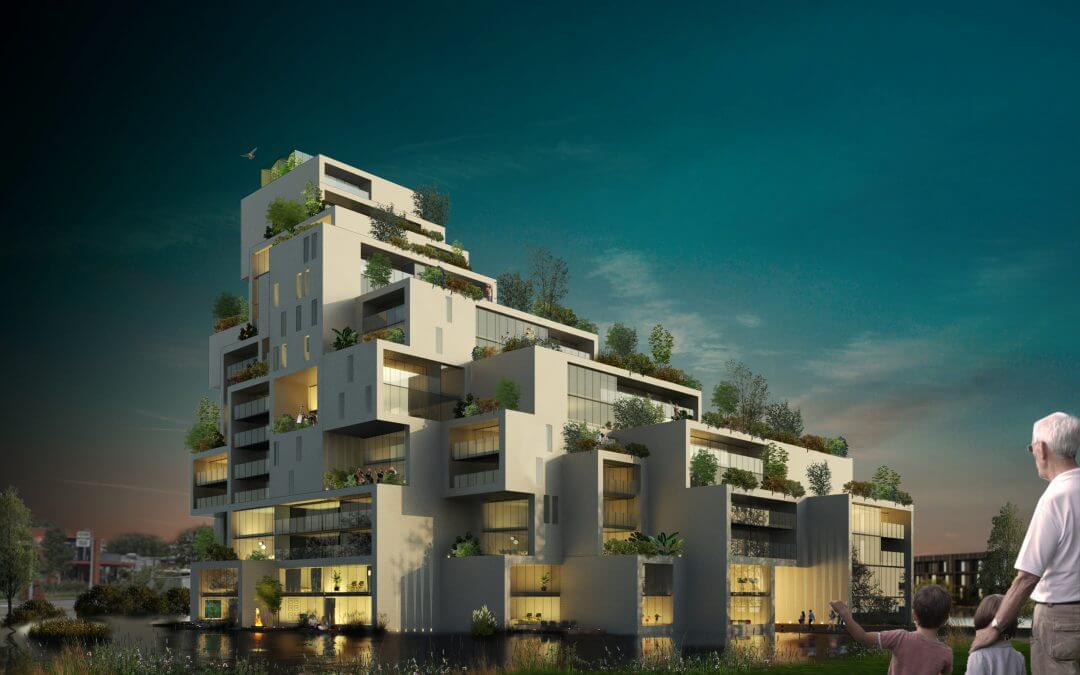‘Is it possible to make highrise corona proof?’, Harm Tilman [editor of de Architect] was asking in his blog of 31 August. His doubt was triggered by the news that the upper floors of many tall office buildings are sitting empty as they have become virtually inaccessible because of corona. Crowding into a lift is asking for contagion. The same is true for residential buildings. Stacked living has been scrutinised since the early stages of the crisis, also for other reasons. Imagine living on the fifteenth floor with no access to a decent amenity space. During pandemics apartments become prisons.
A new approach
Even in the absence of a global virus, highrise living could become more pleasant, healthier, and more sustainable. For the value of real estate, access to greenery and water are as important as flexibility and adaptability. A balcony is in itself no longer sufficient, and access should also be granted to gardens, loggia’s, conservatories, and greenhouses accommodating winter and allotment gardens at higher floor levels. A combination of highrise and earthbound living is possible, in the inner city as well as at its fringes, in suburbia.

The impression and sketch above shows a development of stacked apartments in Alkmaar, where we have been involved since last year. The building has fourteen floors and will be situated at the edge of the city centre. The block is freestanding, so we were able to stagger the apartments. The ground floor apartments have terraces facing water, and and on the upper floors every apartment has a roof terrace, which delivers considerable benefits to the quality of living.
An example of stacked living with a high density is Kavel 14, a study for a residential project in Amsterdam IJburg, where the space available to develop is very limited. The building manifests itself from street level as a strong unity to fit within the urban context of large city blocks. By contrast, the inside of the block is a green oasis, a garden terrace that steps down to street level. The volume of the block is staggered with private and communal gardens and spaces. All apartments, also those at the top levels, have access to a garden, which makes Kavel 14 fit for family units. Children will be able to play outside in a safe environment. Other units will have protected external spaces with plenty of privacy. And all of this occurs at the centre of a dense cityscape.


Revival of the paternoster
A different approach to stacking and greening does not solve the poor access issues associated with highrise construction. Especially for existing highrise developments it will be difficult, if not impossible, to adjust the way apartments are stacked. So the most obvious way to address this issue is to look at the mode of vertical transport.
A modern paternoster could present a solution for existing highrise developments. This is a lift system with continuously moving lift cages, fit to accommodate a maximum of two passengers. This system has been out of vogue since the sixties, because they have not proven to be very safe. ‘Genius or guillotine?’ was the telling headline in the online magazine Flux.
The idea behind the paternoster was indeed a work of genius. It was developed in Great Britain during the industrial revolution to reduce waiting times. It was a brilliant idea in theory, although in reality passengers tended to trip over when boarding or alighting the moving, doorless cages, sometimes with fatal consequences. This horror scenario has been depicted in numerous movies and novels with relish. Ultimately the curtain fell for this system, although paternoster lifts can still be found in old buildings as a curiosity. The former Scheepvaarthuis building in Amsterdam, now a hotel, still has two working versions, although they are now only used for demonstrations.
Lift producers have been looking for solutions. Hitachi presented a solution that resolved the safety issues. The system moves in a loop, just like the traditional paternoster, but it is also able to come to a full stop. It has doors and a control panel. Hitachi claims that this version takes only half of the space of the original paternoster. The downside is that because of the stopping option, queuing of passengers can still occur.
The MULTI system by ThyssenKrupp is a real innovation. It can move vertically as well as horizontally. It requires more space inside the building, so an application in renovated buildings will be costly. But as it can lead to the preservation of real estate, it may still be cost effective.
Sometimes the future dwells in the past.
Bart Mispelblom Beyer

